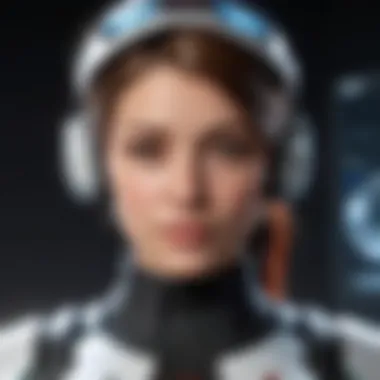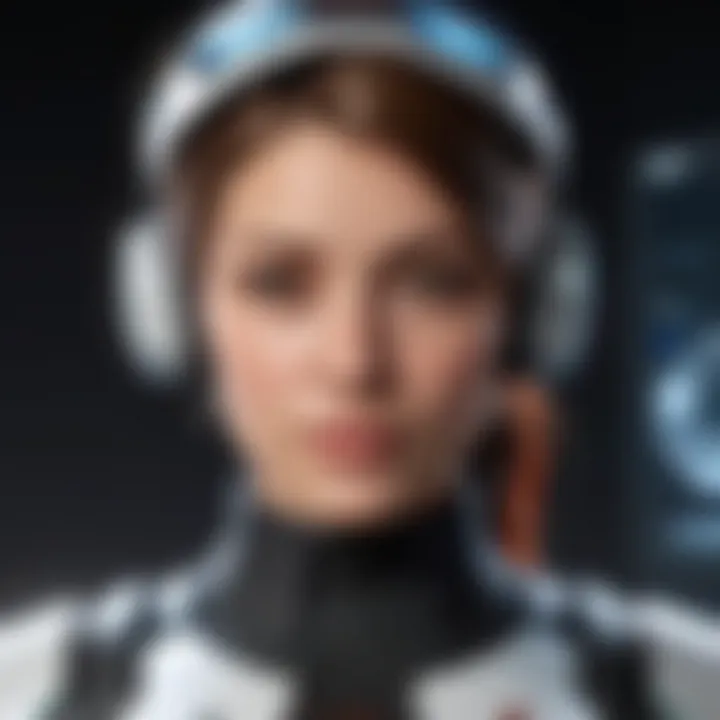Exploring the Unreal Engine 5 Tech Demo: A Comprehensive Analysis


Intro
The Unreal Engine 5 Tech Demo has created waves in the gaming community and beyond. It showcases the future of immersive experiences, pushing the boundaries of what technology can achieve. With this demo, Unreal Engine has demonstrated its aim to redefine graphics and user experiences, interactions, and development workflows for gamers, developers, and the broader digital realm.
The main objective of this analysis is to break down the features presented in the demo and explore their implications for various sectors, particularly gaming. As we delve deeper into the nuances of Unreal Engine 5, we will touch upon its potential utility beyond just game development, examining how these advancements might influence industries such as architecture, film, and education.
Key Points to Discuss
- Groundbreaking features of Unreal Engine 5
- The implications for the gaming industry
- Potential applications beyond gaming
Understanding these aspects will not only clarify the technological advancements showcased but will also give insight into how they will shape future digital experiences. As we embark on this exploration, expect to uncover the layers that contribute to Unreal Engine 5's promise of revolution.
Esports Coverage
Esports continues to grow dramatically, with competitive gaming gaining traction in mainstream culture. The influence of Unreal Engine 5 can extend into this realm, enhancing how games are played, viewed, and experienced.
Pro-Gaming Tournaments
Competitive gaming tournaments are becoming a staple in entertainment. Unreal Engine 5 could provide a separate layer of realism that appeals to players and viewers alike. With its advanced graphical fidelity, the online spectator experience can evolve into something far more engaging.
Player Profiles and Interviews
Understanding the players behind high-level gaming adds depth to the esports narrative. With Unreal Engine 5, developers can craft detailed character models and environments, allowing for a more personalized storytelling approach in these profiles.
Team Strategies and Analysis
Strategizing in esports often happens through analysis of gameplay. The potential adoption of Unreal Engine 5 in training tools could provide detailed insights into team strategies, thereby enhancing performance.
The integration of these features with the esports coverage could redefine how teams prepare and compete. Viewer engagement, team interactions, and even player performance could drastically improve through enhanced graphics and real-time applications.
Quotes and Insights
"The power of Unreal Engine 5 lies in its ability to transform gaming into a spectacle that brings fans closer to the action."
Hardware Testing
For gamers, having the right hardware is essential to maximize performance. Unreal Engine 5 is resource-intensive, and hence suitable hardware testing becomes crucial to ensure smooth experiences.
Reviews of Gaming Monitors
As gameplay becomes more visually demanding, the choice of gaming monitors becomes vital. Gamers should look for monitors with high refresh rates and resolution.
Performance Analysis of GPUs
Graphics Processing Units dictate the capability to render high-quality visuals in real-time. Performance reviews of leading GPUs will help understand how to optimize experiences in UE5 environments.
Comparison of Mechanical Keyboards
While gameplay visuals are critical, the tactile experience provided by a good mechanical keyboard cannot be overlooked. A comparison between popular keyboards can guide gaming setups for comfort and performance.
Game Reviews
Evaluating how Unreal Engine 5 influences specific games can further illuminate its relevance. This section covers notable game releases that utilize UE5 technology, analyzing them for their innovation and user experience.
Latest Game Releases
Games utilizing Unreal Engine 5 technology stand out due to enhanced visual fidelity. Keeping an eye on latest releases will provide a glimpse into the potential of this engine.
Detailed Gameplay Analysis
Breaking down gameplay mechanics in these new titles will offer insight into how the tech demo's features translate into real-world applications. Gamers can expect more intricate systems and interactive environments.
Storyline and Graphics Review
Evaluate the marriage of compelling narratives with stunning graphics powered by Unreal Engine 5. As narratives evolve, understanding how they leverage technology could shape player engagements.
In the end, as we synthesize this information, we aim to unveil the considerable impact of Unreal Engine 5 on gaming and beyond. By outlining the key elements discussed, we hope to provide a comprehensive understanding of the trajectory set for future developments.
Preamble to Unreal Engine Tech Demo
The Tech Demo for Unreal Engine 5 marks a pivotal moment for both developers and gamers. It showcases advanced technologies capable of setting new benchmarks in digital graphics and gameplay experiences. By delving deeper into this demo, the article provides insights into its significance within the broader landscape of game development and interactive media.
Overview of Unreal Engine
Unreal Engine 5, developed by Epic Games, represents the latest evolution in game development technology. It aims to empower creators by delivering tools and architecture that integrate cutting-edge features. Notable components include Nanite, which facilitates virtualized geometry, and Lumen, an innovative global illumination solution. The combination of these features allows for more realistic lighting and detailed environments than ever before. In the current age of digital entertainment, these innovations are key in driving user engagement and higher artistic ambition.
Purpose of the Tech Demo


The purpose of the Unreal Engine 5 Tech Demo extends beyond mere showcase; it serves as both a guide and inspiration for developers. The demo illustrates how the new features can be utilized to create immersive worlds. Moreover, it reflects Epic Games' commitment to redefine the boundary of possibility in game design. Through this demo, potential users gain a clear view of the engine's capabilities, whether for large studios or independent creators. Additionally, it aims to heighten expectations for future games and user experiences, emphasizing the potential transformation in visual fidelity and interactivity.
Key Innovations in Unreal Engine
The advancements in Unreal Engine 5 represent a significant leap in how game developers approach design and functionality. By exploring the key innovations, we can appreciate how these elements enhance both graphical fidelity and development efficiency. The innovations also hold promises for an enriched interactive user experience, enabling developers to create more dynamic worlds and narratives.
Nanite Virtualized Geometry
Definition and Functionality
Nanite is a groundbreaking technology implemented within Unreal Engine 5. It allows for virtualized geometry, meaning that artists can utilize high-quality assets without worrying about polygon count limits. This technology streamlines the rendering process by automatically adjusting level of detail based on the viewer's perspective. Its key characteristic is the capacity to render billions of polygons effortlessly, making it a popular choice among developers. The unique advantage is clear: creators can focus on artistic detail rather than technical restrictions, which opens new doors for cinematic visuals in real-time applications.
Impact on Level of Detail
The impact of Nanite on level of detail is notable. It provides an unprecedented depth of realism where intricate textures and models maintain their quality, regardless of distance. This feature allows developers to populate environments with diverse and rich details, enhancing the player's experience. The vast scope of this technology means that game worlds can come to life with high fidelity, which was previously unimaginable. However, it does necessitate powerful hardware, limiting its use for some smaller indie developers.
Lumen Global Illumination
Real-time Lighting Solutions
Lumen serves as a robust solution for dynamic global illumination in Unreal Engine 5. This enables real-time updates to lighting scenarios, enhancing how light interacts within a scene based on environmental changes. The notable aspect of Lumen is its ability to work economically with the scene's structure, providing photorealistic lighting effects. This innovation is advantageous as it eliminates long baking times associated with global illumination, thus streamlining workflow. The major drawback may come from the high-demand on system resources, which could be a limitation for developers with less powerful machines.
Enhancements in Visual Quality
The enhancements in visual quality through Lumen are evident when comparing Unreal Engine 5 to previous iterations. The system's sophistication in replicating realistic light and shadow creates immersive atmosphere crucial for gaming. Many players are drawn to beautifully lit environments that enhance emotional responses and engagement. However, there is a need to optimize it for various platforms, as discrepancies in performance across devices sometimes occur. Despite this, the boost to visual quality through this technology is thoroughly beneficial in meeting modern gaming expectations.
Metahuman Technology
Character Realism
Metahuman technology represents a paradigm shift in character creation. This facilitates the development of highly realistic human characters, with detailed animations and facial expressions. One of the defining features is the ease of generating characters that look lifelike, a task that typically requires extensive skill and labor. The characteristic realism appeals to developers aiming to create engaging and relatable characters, fostering connections with players. However, implementing such high-level realism also raises questions about hardware capabilities and animation fidelity in different environments.
Applications in Gaming and Beyond
The applications of metahuman technology extend beyond gaming. For film and virtual reality, this technology allows for a more engaging narrative experience by creating characters that audiences can connect with. The advantage of using such detailed avatars enhances storytelling, making them feel familiar and real. There may be some concerns about the resources needed to maintain this realism in varied applications, but the potential for wider usage presents an exciting opportunity for the industry.
"The innovations in Unreal Engine 5 not only enhance gameplay but also redefine what visual storytelling can achieve."
The innovations in Unreal Engine 5 position it at the forefront of technology in gaming. As developers harness the power of Nanite, Lumen, and Metahuman technology, the possibilities for creativity and storytelling are endless.
Technical Aspects of the Tech Demo
Understanding the technical aspects of the Unreal Engine 5 Tech Demo is essential for grasping its impact on game development. These elements not only define the capabilities of the engine but also set expectations for hardware and optimization. This section aims to detail the essential hardware requirements and optimization techniques that developers need to consider when utilizing Unreal Engine 5.
Hardware Requirements
Minimum Specifications
The minimum specifications for Unreal Engine 5 are designed to ensure that developers can run the engine on basic systems. This aspect is crucial because it allows a wider range of developers, particularly those who are indie or hobbyists, to experiment with the technology.
The key characteristic of the minimum specifications is its accessibility. By setting relatively low requirements, Epic Games enables more users to engage with the tech demo, providing opportunities for learning and creativity. Components such as a quad-core CPU and a mid-range GPU are part of this configuration. However, while this setup is beneficial, it may limit the visual fidelity and performance of the demos, potentially hindering the experience.
The unique feature of minimum specifications is that it creates a foothold for those who want to explore Unreal Engine 5 without major investments. This can be a double-edged sword, though, as developers may not fully appreciate the engine's capabilities unless they upgrade. Thus, while suitable for basic exploration, the limitations may impede deeper engagement with the powerful features showcased in the engine.
Recommended Specifications
On the other hand, the recommended specifications take advantage of more advanced hardware capabilities. This configuration supports higher visual production values and a better overall user experience. Developers using these specifications can fully take advantage of the engine's key features such as Nanite and Lumen, allowing for stunning graphics and real-time global illumination.
The recommended specifications typically include components like a recent multi-core CPU and a high-end GPU such as NVIDIA's RTX series. This choice is beneficial as it ensures smooth performance and higher frame rates, which are essential for game development and testing.
Unique features of recommended specifications include better memory bandwidth and ray tracing capabilities. These enhancements do come with increased costs, which can be a barrier for small studios or indie developers. However, they are crucial for maximizing the demo's potential and leveraging Unreal Engine 5's advanced technologies.
Optimization Techniques
Asset Management
Effective asset management is a vital part of working with Unreal Engine 5, particularly given its capabilities. This aspect of development focuses on how assets are organized, stored, and utilized within a project. Effective management allows teams to maintain efficiency, particularly in large projects where the number of assets can be overwhelming.
The key characteristic of asset management is organization. By employing a robust asset management strategy, developers can streamline their workflows, making it easier to locate and replace assets as needed. This contributes significantly to overall project efficiency, allowing teams to focus on content rather than logistics.
Unique features of proper asset management include version control and documentation. These elements enhance collaboration among team members and ensure that assets remain updated as projects evolve. However, if not prioritized, poor asset management can lead to chaos and wasted resources, impacting timelines and budgets negatively.
Rendering Strategies
Lastly, rendering strategies play a crucial role in how visuals are generated within Unreal Engine 5. This aspect includes techniques for optimizing scene rendering to achieve high visual fidelity without overloading the hardware capabilities.
The key characteristic of rendering strategies is efficiency. By employing various techniques, developers can reduce render times and enhance performance in real-time applications. This is particularly beneficial for developers creating photorealistic experiences, as it allows users to maintain a high level of detail while keeping frame rates stable.


Unique features of robust rendering strategies often include various optimizations such as level of detail (LOD) management and culling techniques. These strategies help in decreasing the rendering load on hardware while maintaining visual quality. However, they require a deep understanding of the engine's capabilities and may necessitate extensive testing.
"Understanding hardware requirements and focusing on optimization can greatly enhance the development process within Unreal Engine 5, making it accessible and efficient across various projects."
Developers who grasp these technical aspects are better equipped to harness the full potential of Unreal Engine 5, paving the way for innovative and visually striking gaming experiences.
Comparative Analysis with Previous Versions
Understanding the comparative analysis of Unreal Engine 5 with its predecessors is crucial to grasp the significance of its advancements. This section highlights specific elements, benefits, and essential considerations relevant to the ongoing evolution of game development technology. By assessing these changes, we can appreciate how the new engine builds upon the foundation set by Unreal Engine 4 and its previous iterations.
Transition from Unreal Engine
Improvements in Graphics
The graphical improvements between Unreal Engine 4 and 5 are distinct and impactful. One key aspect of Improvements in Graphics is the new rendering technology, which allows for more complex scenes without sacrificing performance. The introduction of features such as Nanite ensures finer details can be captured and rendered in real-time.
This ability provides developers with a greater freedom to explore creativity in their designs. Fine textures and realistic environments elevate the visual experience, making games more immersive. The integration of Lumen for dynamic lighting further enhances this experience. However, such advancements can create performance concerns for lower-end hardware, necessitating careful optimization and balancing.
Workflow Enhancements
Workflow Enhancements in Unreal Engine 5 streamline production, making it more efficient for developers. A pivotal development is the improved asset management system, which reduces loading times and enhances the integration process of different assets into projects. This change enables seamless transitions between design and deployment phases.
Another notable feature is the enhanced user interface that simplifies navigation and task management. These enhancements are beneficial because they save time and reduce complexity in the development cycle. Although these improvements might require a learning curve for seasoned developers accustomed to previous versions, the long-term benefits justify the transition.
Industry Reception
Developer Feedback
Developer feedback plays a significant role in understanding the reception of Unreal Engine 5. Many professionals highlight the improvements in graphics and workflows as game-changers. The feedback reflects optimistic perceptions about the potential the engine offers in creating more visually stunning and mechanically robust games.
Moreover, community forums and developer spaces have reported positive correlation between the new features and productivity increases. However, some critiques mention the software's demanding requirements that may not be accessible to all developers. Balancing advancements while maintaining performance accessibility remains a key discussion point.
Player Expectations
Player expectations from games developed with Unreal Engine 5 are notably elevated. Due to the enhanced graphics and interactive capabilities, audiences now anticipate unparalleled visual quality and richer storytelling experiences. This creates a pressure on developers to deliver high-quality content that meets and exceeds these expectations.
The unique feature of the dynamic environments supported by Lumen and Nanite contributes to this anticipation. However, with higher expectations comes the criticism regarding performance issues. Gamers expect not just visual fidelity but also reliable gameplay across various platforms. Balancing high standards in graphics while ensuring playability remains a critical challenge ahead.
Potential Impact on Game Development
The Unreal Engine 5 Tech Demo showcases a substantial potential reshaping of the game development landscape. This shift brings with it significant benefits, informing how creators approach their projects and interact with emerging technologies. The ability to harness advanced tools enables a wider range of developers, particularly those operating on smaller budgets, to push their creative boundaries in remarkable ways.
Citizen Development
Accessibility for Indie Developers
Accessibility for Indie Developers has become a defining feature of Unreal Engine 5. The platform comes equipped with user-friendly tools and features that lower the barrier to entry for new creators. Developers no longer require extensive knowledge of programming; the visual scripting system allows them to focus on artistic and gameplay aspects. This democratization of game creation encourages innovation and experimentation, fostering a more extensive and diverse game development community.
One of the key characteristics of this accessibility is the intuitive interface. It makes learning easier for beginners compared to previous iterations of Unreal Engine. Indie developers benefit from a wealth of online resources that support learning and implementation. This can lead to a more collaborative atmosphere where knowledge is freely shared. However, the ease of access can sometimes lead to a saturation in the marketplace. As more games flood the digital space, standing out becomes more challenging.
New Opportunities for Creation
New Opportunities for Creation open up as Unreal Engine 5 continues to evolve. The tech demo demonstrates innovative features that empower developers to produce high-quality games with limited resources. This platform supports photorealistic visuals and intricate environments, which traditionally required high budgets and substantial teams to achieve.
A unique feature within this category is the ability to easily integrate assets from the Megascans library. Developers can access an expansive library of high-resolution textures and models, significantly speeding up development time. While this can enhance creativity and speed up project completion, it may also result in a homogeneity of visual styles across many projects. Developers must remain vigilant and push for originality to maintain unique identities.
Evolving Player Experience
Immersive Storytelling
Immersive Storytelling emerges as a vital component of the gaming experience, partly due to the capabilities of Unreal Engine 5. With enhanced graphics and narrative tools, developers can create richer storylines that resonate with players deeply. This tech demo illustrates seamless character interactions and expressive animations that contribute to more engaging narratives.
One key characteristic is the ability to craft dynamic environments that respond to player actions. Such interactivity fosters a deeper connection to the story. However, developers must balance sophisticated mechanics with accessibility, ensuring that the immersive experience does not alienate players unfamiliar with complex gameplay systems.
Interactivity Enhancements
Interactivity Enhancements are transformative in the gaming landscape, allowing players to experience worlds as never before. Unreal Engine 5 leverages advanced technologies that offer possibilities for responsive gameplay and intricate design. Players can interact with environments in ways that create a sense of agency and presence.
A defining feature is the implementation of real-time environmental changes that mirror player choices. This capability elevates engagement and provides a personalized experience. While players may appreciate these rich interactions, developers need to understand the implications on resource management and testing, as these features can complicate development cycles. Developers must find a balance, ensuring that interactivity enriches rather than complicates the experience for players.
Broader Applications Beyond Gaming
Unreal Engine 5's advancements have implications that extend well beyond the realm of gaming. Its potential applications reach into sectors like film, animation, architecture, and various other fields where high-quality visualization is essential. Understanding these broader applications is vital as it showcases how the technology can enhance creativity, improve workflows, and offer new opportunities for diverse industries.
The robust graphics capabilities and innovative tools of Unreal Engine 5 can significantly impact how creators in non-gaming sectors approach their projects. The ability to render photorealistic environments in real-time remains a standout characteristic, allowing professionals to visualize concepts with accuracy and efficiency.
Film and Animation


Virtual Production Techniques
Virtual production represents a revolutionary shift in how films and animations are created. This technique allows filmmakers to create and manipulate digital environments during production, rather than solely relying on post-production effects. One key characteristic of virtual production is its ability to integrate live-action footage with digital environments in real-time. This combination is beneficial for achieving complex shots that traditionally require extensive CGI work.
Virtual production enables directors and actors to perform against backdrops that provide immediate visual context, enhancing performances and reducing the need for later adjustments. The unique feature here is the ability to utilize tools like LED screens that can reflect real-time changes in the environment, offering a dynamic backdrop that remains faithful to the lighting and context of the scene. This innovation saves time and costs, making it a popular choice among filmmakers today.
Seamless Integration with Filmmaking
Seamless integration is another essential aspect of using Unreal Engine 5 in filmmaking. This technology allows for a fluid workflow across disciplines. Creatives can collaborate easily, sharing assets and ideas in real-time, which improves overall productivity.
One of the most appealing characteristics of this integration is the way it brings together different creative professionals. Artists, animators, and directors can collaborate in an immersive virtual space, allowing them to make decisions on the fly and see immediate results. A unique feature of this approach is the enhanced communication it fosters between team members, leading to more cohesive storytelling. However, it is crucial to consider that the technology may require upskilling. Teams need to adapt to new workflows, which can be a challenge for some.
Architectural Visualization
Realistic Renderings
Architectural visualization involves creating lifelike representations of buildings and spaces before they are constructed. Unreal Engine 5 excels in this area due, in part, to its realistic rendering capabilities. This technology allows architects to provide clients with a vivid picture of what their projects will look like. A key characteristic of realistic renderings is the depth of detail, whether it be in textures, lighting, or materials.
The appeal lies in the ability to offer interactive walkthroughs, allowing stakeholders to experience spaces as if they are physically present. A distinct advantage here is that potential issues can be identified early in the design process, saving time and money in revisions. However, exceedingly high detail can require significant hardware investments, which may limit access for some smaller firms.
Client Presentation Enhancements
Client presentation enhancements involve utilizing the capabilities of Unreal Engine 5 to improve how architectural designs are presented to clients. This aspect focuses on creating visually engaging narratives around architectural projects, rather than just static images or drawings. One primary characteristic is the interactivity incorporated into presentations, allowing clients to explore and manipulate visualizations according to their preferences.
This approach is beneficial as it fosters a better understanding of projects, leading to more informed discussions. Clients can visualize their choices without ambiguity, leading to smoother decision-making processes. However, it does require a certain level of technical know-how to create these presentations effectively, which can be daunting for some in the architecture field.
Future Directions for Unreal Engine
In the rapidly evolving landscape of digital content creation, the future directions for Unreal Engine are vital. This section outlines significant developments that may shape the way developers create games and applications. Understanding these directions is essential for those anticipating innovations and improvements in real-time graphics and interactive experiences.
Updates and Community Contributions
Marketplace Dynamics
Marketplace dynamics in Unreal Engine have emerged as a pivotal component. This aspect refers to the ecosystem of asset sales and exchanges among developers. The marketplace provides a platform for creators to share and sell their digital assets, such as 3D models, sound packs, and code scripts.
One key characteristic is its accessibility. It allows small developers access to high-quality assets, thereby reducing development time and costs. This is particularly beneficial for indie developers who may not have the resources to create every component from scratch. The diverse range of offerings encourages creativity and experimentation, leading to enhanced game experiences.
However, a unique feature of the marketplace is its continuous feedback loop. Developers can rate and review assets, fostering a community of quality control. The downside can be the saturation of less polished assets due to the open nature of submissions, which can challenge quality assurance.
Open Source Contributions
Open source contributions play a crucial role in the ongoing development of Unreal Engine. This specific aspect enables developers from various backgrounds to contribute to the engine's codebase, thus enriching its capabilities.
One of the key characteristics is the collaborative spirit it nurtures within the community. Developers can share code snippets, innovative solutions, and bug fixes. This collaboration leads to faster troubleshooting and enhancements, benefiting the entire ecosystem.
The unique feature of open source contributions lies in its transparency. Any developer can inspect, modify, and improve the code, fostering an environment of collective ownership. However, it does come with challenges. Not all contributions maintain the same standards, which can complicate integration into the main framework.
Anticipated Developments
Expanding Collaborative Ecosystems
Expanding collaborative ecosystems represent another significant direction for Unreal Engine's future. It focuses on interconnectedness among different development teams, tools, and platforms. This collaborative aspect enhances creativity and resource sharing across projects.
The key characteristic here is the cross-platform compatibility that Unreal Engine promotes. By allowing developers from various sectors to work together seamlessly, it fosters innovation. Collaborative efforts can lead to groundbreaking ideas and developments that may not have surfaced in isolated environments.
A unique feature of this ecosystem is its emphasis on community-driven projects. These projects often leverage contributions from multiple developers, leading to richer content and a more extensive network of supporters. Despite the considerable benefits, challenges may arise in aligning objectives and ensuring quality across all contributions.
Integration of AI in Development
The integration of AI in development processes is perhaps one of the most anticipated directions. This feature signifies the use of artificial intelligence to assist in various aspects of game design and development.
A key characteristic of this integration is automation. AI can streamline repetitive tasks such as asset creation or scene optimization, freeing up developers to focus on higher-level aspects of their projects. This efficiency is vital as projects grow in complexity.
Moreover, a unique feature is the potential for AI-driven analytics. Developers can gain insights into player behaviors and preferences, allowing for more tailored gaming experiences. Although there are numerous advantages, concerns about dependency on AI tools may emerge. Developers must be cautious not to lose the human element that is crucial in storytelling and design.
Ending: The Future of Real-Time Graphics
The significance of real-time graphics has reached new heights in the context of the Unreal Engine 5 Tech Demo. The advancements presented in this demo not only showcase the power of technology but also herald a new era in digital content creation. This section aims to explore the critical factors that shape the future of real-time graphics, anticipatinfg notable changes in not just gaming but also other visual media contexts.
The incorporation of features like Nanite and Lumen within Unreal Engine 5 sets a precedent for unparalleled realism and efficiency in rendering. These technologies enable creators to focus on artistic expression rather than becoming bogged down with technical limitations. This shift enhances the overall experience for developers and end-users, allowing for more immersive storytelling and engaging gameplay.
As the landscape of software evolves, the real-time graphics sector is poised to benefit significantly. Collaboration between tech companies and creators is expected to increase, fostering innovative solutions that could be leveraged across various platforms. Moreover, the creative industry can anticipate an influx of new opportunities that arise from tools capable of breaking existing molds. Integrating AI into this ecosystem will only further advance the capabilities and potential of real-time graphics.
"The future of real-time graphics is not just about making visuals look good; it is about enabling storytelling and creativity in ways we have yet to imagine."
Summary of Key Takeaways
- Advancements in Realism: Unreal Engine 5 introduces features such as Nanite and Lumen, which significantly enhance graphical fidelity and rendering efficiency.
- Impact on Development: The technology streamlines workflows, allowing artists to prioritize creativity rather than technical constraints.
- Cross-Industry Applications: Beyond gaming, these advancements can apply to sectors like film and architecture, transforming how professionals approach their craft.
- Future Collaborations: Expect increased partnerships between technology developers and creative professionals, paving the way for innovation.
Final Thoughts
The Unreal Engine 5 Tech Demo marks a crucial juncture in the evolution of real-time graphics. Developers now have access to tools that were once reserved for the most powerful studios. The shift toward more accessible, powerful technology opens up new avenues for independant creators and large studios alike.
By embracing these emergent capabilities, the industry as a whole can drive towards a richer, more vibrant future in digital experiences. As audiences become more demanding of realistic graphics and immersive gameplay, the pressure is on developers to meet and exceed these expectations. The implications of Unreal Engine 5 extend far beyond simple enhancements; they represent a foundational shift in how stories are told and experienced across digital platforms.



